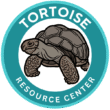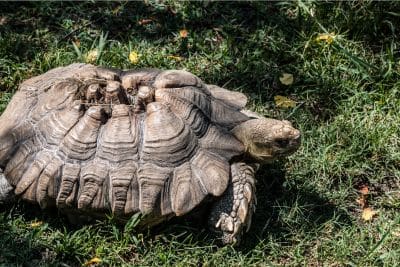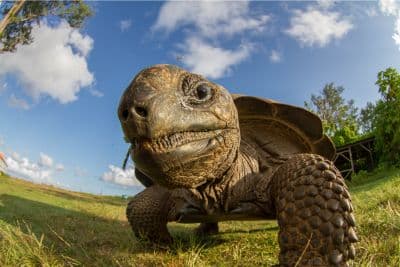Welcome my comprehensive guide that covers tortoise FAQs related to their health and anatomy. I have designed it to help tortoise enthusiasts better understand and care for their shelled companions.
In the article, you’ll find detailed insights into common health issues that tortoises face, including symptoms, causes, and preventive measures to ensure their well-being.
You will find details of the most common conditions that affect captive tortoises including respiratory infections, shell rot, and metabolic bone disease, and I have also provided some practical advice on how to prevent and manage these problems.
Additionally, you’ll be able to explore the anatomy of tortoises, highlighting the significance of their scutes, shells, and limbs. You’ll learn about the protective and functional aspects of a tortoise’s shell, the role of scales on their legs, and fascinating details about their sensory abilities, such as hearing, vision, and taste.
Whether you’re a new tortoise owner or an experienced caretaker, this article provides valuable knowledge to help you maintain the health and happiness of your tortoise. Dive in to discover essential tips and facts about these remarkable reptiles and their unique anatomical features.
Common Health Problems in Tortoises
Most tortoise-related health issues occur because of insufficient care or inadequate environmental conditions and can be avoided if their diet and living conditions can be matched with their natural habitat.
Here’s a breakdown of the most common health problems seen in captive tortoises, plus symptoms, causes and the best ways to prevent them occurring.
| Problem | Symptoms | Causes | How to Prevent |
| Respiratory Infections | Wheezing, runny nose, lethargy, and loss of appetite | Cold or excessively damp conditions | Research appropriate temp and humidity for your species. Avoid misting substrate in the afternoon or evening. |
| Shell rot (fungal or bacterial infections of the shell) | Flaking, lesions, discoloration or softening of the shell and / or foul smell. Loss of appetite. | Lack of humidity and cracks or injury to the shell caused by accidents or attacks. | Ensure correct temperature, light, humidity and diet for your tortoise species. Keep enclosure clean and protect from injury. |
| Shell pyramiding* | Abnormal shell growth | Poor nutrition, inadequate humidity and / or lack of UVB. | Ensure correct light and humidity plus a calcium and phosphorus-rich diet. Avoid overfeeding. |
| Parasites (internal worms) | Weight loss, lethargy, visible signs in faeces | Consumption of contaminated water, food, or faeces. | Spot clean substrate to remove faeces & uneaten food, and sanitise water bowl & replace with fresh water daily. |
| Parasites (external ticks and mites) | Noticeable insects on shell and limbs. Irritation may cause tortoise to scratch excessively. | Transferred from other animals. | Quarantine animals for at least 6 months before integrating with other pets. |
| Metabolic Bone Disease (MBD) | Soft, weak bones and a deformed shell | Inadequate UVB lighting and dietary imbalances (particularly calcium and vitamin D3). | Provide a fiber-rich varied diet and supplement with vit and mineral powder sprinkled onto food. |
| Vitamin Deficiencies | Swollen eyes and respiratory problems caused by vitamin A deficiency. Gastrointestinal problems like constipation caused by lack of fiber. | Lack of variety in diet (over-reliance on commercial foods) and insufficient UVB exposure. | Provide a varied diet. Sprinkle vitamin and mineral supplements on food. Ensure sufficient light, temperature and humidity. |
| Gastrointestinal Issues | Constipation, diarrhea, and impaction (blockage) | Lack of dietary fiber, or excessive protein and sugar and / or dehydration. | Avoid feeding fruit and meat, bathe regularly, provide drinking water daily. |
| Kidney Disease (especially older tortoises) | Dehydration, lack of appetite, lethargy, weight loss, swollen legs or abdomen. | Old age, toxicity, high protein, dehydration, environmental stress. | Maintain appropriate temperature, light, and heat. Keep fresh water topped up daily and bathe regularly. Stick to a varied, high fiber diet. |
| Vitamin Toxicity | Weakness, lethargy, excessive thirst, urination issues, loss of appetite. | Over-supplementation, particularly of vitamins A and D. | Provide a balanced diet, seek veterinary advice about correct supplement dosage. |
| Heat Stress and Dehydration | Lethargy, panting, sunken eyes, loss of skin elasticity, hardened faeces. | Overexposure to high temperatures or inadequate access to water. | Ensure adequate shade, shelter, and water. |
* Shell Pyramiding – “Pyramiding” in tortoises refers to a condition in which the shell’s scutes grow in an abnormal, pyramid-like shape, rather than lying flat. This condition is often seen as a series of raised, pointy bumps on the shell, making it look more rugged or jagged than smooth.
In pet tortoises, pyramiding is typically a sign of poor husbandry, and is most caused by a diet low in calcium or high in protein, lack of humidity (especially in forest tortoises), and / or, a lack of UVB (that can hinder their ability to absorb sufficient calcium).
Tortoise Stress
Stress is common in tortoises and is most often caused by poor diet (that can lead to nutrient deficiencies) digestive issues, diseases or infections, or an enclosure that is either too small, or doesn’t provide enrichment opportunities.
A stressed tortoise is likely to withdraw into its shell or take refuge in a shelter. Other signs include a loss of appetite, increased aggression, hissing, biting, pacing, or circling.
Physical signs of stress can include a runny nose, wheezing, swollen eyes, or changes in fecal consistency. These symptoms tend to indicate stress-related health issues, caused by illness. If you see your tortoise scratching excessively, this may indicate that they are trying to relieve stress or discomfort.
Changes in the appearance of a tortoise’s shell, such as dullness or pyramiding, are usually linked to nutritional stress or stress caused by inadequate habitat conditions.
Tortoise Anatomy
Shell
Tortoises have shells primarily for protection and camouflage, but also to provide structural support for their body, and to absorb and retain heat from the sun, allowing them to thermoregulate. Both tortoises and turtles are similar in this regard.
Additionally, their shell serves as a reservoir for calcium so that during periods of deficiency, or during reproduction (when females need extra calcium for eggshell production), these minerals can be mobilized from the bone of the shell.
Carapace
The carapace is the top, dome-shaped part of a tortoise’s shell. It serves several crucial functions, including protection, structural support, and thermoregulation. The carapace is composed of two primary layers:
Bone Layer: The underlying structure of the carapace is made up of fused bones, including the tortoise’s ribs, vertebrae, and other skeletal elements. This bony layer provides robust structural support and serves as a protective barrier against predators and environmental hazards.
Scute Layer: Tortoise scutes are the shield-like plates that make up the outer layer of a tortoise’s shell. They cover the bony shell beneath and are made of keratin which provides protection against environmental elements and predators.
Like tree rings, scutes often display growth rings that can help indicate the age of a tortoise, especially in younger individuals. Each ring generally represents a period of growth, which can sometimes be linked to seasonal changes.
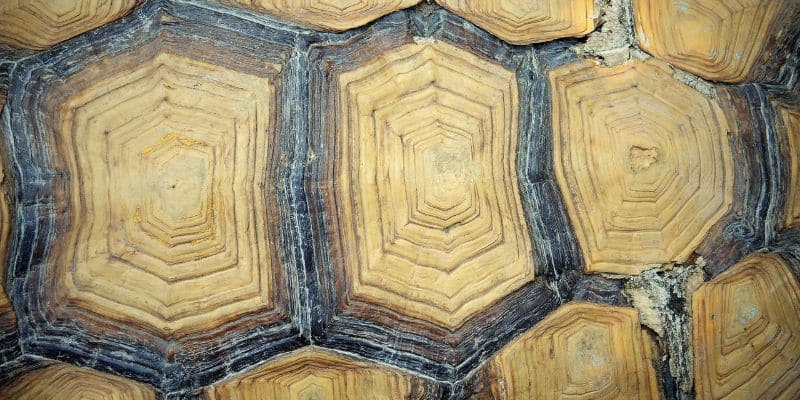
Scutes are arranged in a specific pattern on the carapace (top part of the shell) and the plastron (underside).
Although the pattern and exact number varies among species, the main scutes on the carapace include the vertebral scutes (running down the center), costal scutes (on the sides), and marginal scutes (around the edge).
The condition of a tortoise’s scutes can tell a lot about its health and the care it has received. For example, pyramiding (where scutes become raised and form a pyramid shape) can indicate malnutrition or improper humidity levels in their environment.
Plastron
The bottom part of a tortoise’s shell is called the plastron. Like the carapace, the plastron is composed of bony structures covered by keratinous scutes. It provides additional protection for the tortoise’s underside and internal organs.
The plastron has its own set of scutes, including the gular, humeral, pectoral, abdominal, femoral, and anal scutes.
The plastron is connected to the carapace by bony bridges, creating a rigid and protective shell structure that encases the tortoise’s body.
Are You Starving Your Tortoise?
Save 10% on premium tortoise food and supplements from Tortoise Resource Center on Amazon now using code BUYNOWGET10
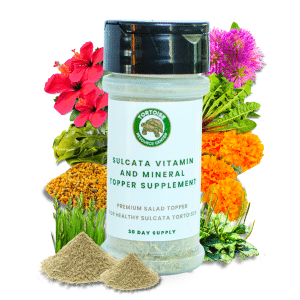
Sulcata Vitamin & Mineral Topper Supplement
30-Day Supply | 2 oz (56 g)
$24.99
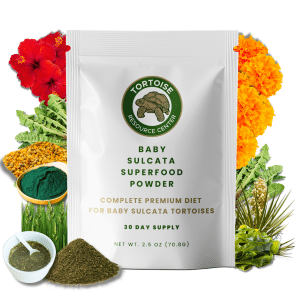
Baby Sulcata Tortoise Superfood Powder
30-Day Supply | 2.5 oz (70.8 g) Bag
$24.99
Purpose
The shell structure is vital for a tortoise’s defense, as it allows them to retract their head, limbs, and tail into the shell for protection against predators or other threats. This is a key defensive mechanism, as they are generally slow-moving and cannot quickly escape from danger.
The degree to which different species of tortoises can retract varies. Both the Hinge-back and the Asian Forest tortoise can seal their shells almost completely, thanks to a hinged plastron that can close the openings.
Some tortoises have notches in their shell near their head either on the carapace (top part of the shell), known as the nuchal scute, or at the front of the plastron (the bottom part of the shell), known as the gular scute.
These notches provide additional flexibility if the tortoise withdraws its head into its shell and allows for better protection against predators. The presence and shape vary depending on habitat and lifestyle and can sometimes be used to differentiate between species or subspecies.
For example, desert dwellers such as the Gopher tortoise and the Texas tortoise have slight notches near the carapace and a pronounced gular scute. Mediterranean Hermann’s have a slight nuchal scute, and Marginated tortoises have a noticeable notch on the upper shell.
Limbs
Tortoises have short, sturdy and surprisingly strong legs and claws. This adaptation enables them to gain traction on rough surfaces, maneuver over difficult terrain, and burrow into even the driest or most dense ground.
The scales on a tortoise’s legs are a crucial adaptation that enhances their ability to survive in the wild. The tough armor-like texture and color act both as protection from predators and the rough terrain in which they roam.
The scales also help in thermoregulation. In hot weather, this thick outer layer of protection helps to retain water to prevent dehydration and avoid overheating, and in cold weather, tortoises expose their scaled legs to the sun to warm up.
Despite the scaley appearance, it’s possible for tortoises to get sunburnt easily. In their natural habitats, they avoid the extremities of the sun by using shade and burrows to protect themselves from excessive UV radiation.
In captivity, it’s important to provide a habitat that mimics this natural behavior with areas of both sun and shade. This will help them to regulate their temperature and avoid overexposure to sunlight, which can lead to sunburn.
Hearing
Tortoises have internal ear structures that allow them to perceive vibrations and low-frequency sounds.
Although their hearing capabilities are not as advanced as other animals, they are adapted to their specific ecological needs. Their range of hearing helps them detect predators or other dangers, as well as communicate with each other, especially during mating season.
Taste
Tortoises have taste buds that enable them to taste, but not enough to allow them to discern different flavors.
They tend to prefer certain foods over others, suggesting they can distinguish between different tastes and opt for foods that their bodies crave. This enables them to avoid toxic foods and be drawn toward foods with a high nutritional content.
Mouth Parts
Tortoises do not have teeth, but they do have a hard, sharp beak that they use to cut and chew their food. This beak is effective at handling a variety of food items, including plants, fruits, and in some species, even small insects, or carrion.
The beak is made of keratin, the same material that makes up human fingernails and hair. It continues to grow throughout their life, and the act of eating helps to wear it down and keep it shape.
When taking in water, a tortoise will submerge its head and open its mouth to allow water to enter.
They do not have a lapping motion like dogs or cats. Instead, they create a low-pressure vacuum to suck the water in. Tortoises may move their legs or rock their bodies slightly to help pump the water down.
Besides using their mouth parts for drinking, tortoises can also absorb water through their cloaca, an opening used for excretion and reproduction.
Vision
Just like humans, tortoises have cone cells in their eyes, which enable them to perceive different colors. This color vision helps them distinguish between various types of vegetation, allowing them to select the most nutritious options.
Color perception also plays a role in social interactions and breeding behaviors, as tortoises respond to visual cues related to the physical appearance of potential mates.
Tortoises are adapted to daytime activity and rely more on good light conditions to see effectively. Consequently, they have limited vision in the dark.
Like many reptiles, they do not have a tapetum lucidum. This is found in the eyes of many nocturnal animals and is the reflective layer behind the retina that enhances night vision by reflecting light back through the retina.
When light levels are low, they rely more on their sense of smell and touch and tend to be less active, often choosing to rest or sleep until daylight returns.
Body Temperature Regulation
Tortoises are cold-blooded, also referred to as “ectothermic”. This means they rely on external sources of heat to regulate their body temperature (thermoregulate).
They do this by basking in the sun to warm up and seeking shade to cool down, as well as burrowing into the ground.
Burrowing is especially useful for helping to keep their body temperature in check. When it’s cold, they seek refuge underground to evade dipping temperatures and when it’s hot, they sink into the cooler, moist ground below to help keep them hydrated.
They also alter their body position relative to the sun by either exposing more of their body to increase warmth or minimizing exposure to reduce heat absorption.
Additionally, they adjust their daily activities based on the temperature. For example, they tend to be active during the cooler parts of the day in very hot climates and less active during colder periods.
Bathing
Many species benefit from regular soaking, which helps with hydration and maintaining kidney function. This is particularly important for desert-dwelling species that have adapted to limited water availability in their natural habitats.
Citations
Research Gate – The Dawn of Chelonian Research
Western College of Veterinary Medicine – Understanding MBD
